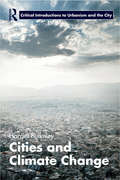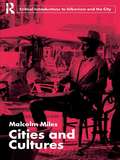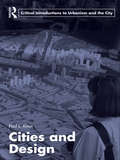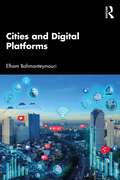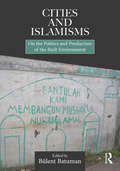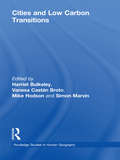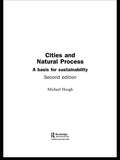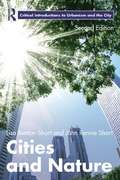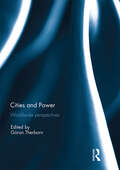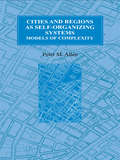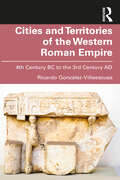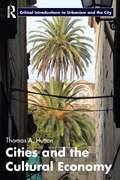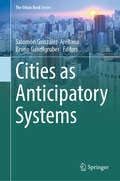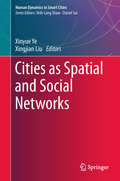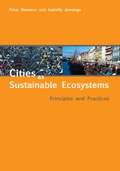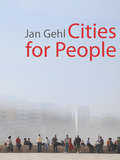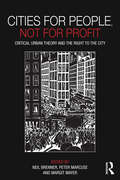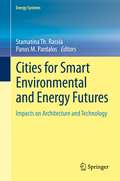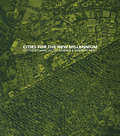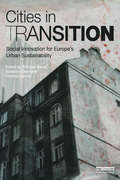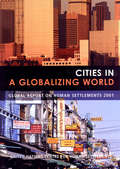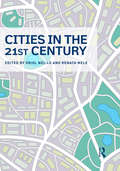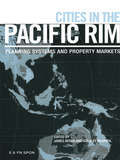- Table View
- List View
Cities and Climate Change (Routledge Critical Introductions to Urbanism and the City)
by Harriet BulkeleyClimate change is one of the most significant global challenges facing the world today. It is also a critical issue for the world’s cities. Now home to over half the world’s population, urban areas are significant sources of greenhouse gas emissions and are vulnerable to the impacts of climate change. Responding to climate change is a profound challenge. A variety of actors are involved in urban climate governance, with municipal governments, international organisations, and funding bodies pointing to cities as key arenas for response. This book provides the first critical introduction to these challenges, giving an overview of the science and policy of climate change at the global level and the emergence of climate change as an urban policy issue. It considers the challenges of governing climate change in the city in the context of the changing nature of urban politics, economics, society and infrastructures. It looks at how responses for mitigation and adaptation have emerged within the city, and the implications of climate change for social and environmental justice. Drawing on examples from cities in the north and south, and richly illustrated with detailed case-studies, this book will enable students to understand the potential and limits of addressing climate change at the urban level and to explore the consequences for our future cities. It will be essential reading for undergraduate students across the disciplines of geography, politics, sociology, urban studies, planning and science and technology studies.
Cities and Cultures
by Malcolm MilesCities and Cultures is a critical account of the relations between contemporary cities and the cultures they produce and which in turn shape them. The book questions received ideas of what constitutes a city's culture through case studies in which different kinds of culture - the arts, cultural institutions and heritage, distinctive ways of life - are seen to be differently used in or affected by the development of particular cities. The book does not mask the complexity of this, but explains it in ways accessible for undergraduates. The book begins with introductory chapters on the concepts of a city and a culture (the latter in the anthropological sense as well as denoting the arts), citing cases from modern literature. The book then moves from a critical account of cultural production in a metropolitan setting to the idea that a city, too, is produced through the characteristic ways of life of its inhabitants. The cultural industries are scrutinised for their relation to such cultures as well as to city marketing, and attention is given to the European Cities of Culture initiative, and to the hybridity of contemporary urban cultures in a period of globalisation and migration. In its penultimate chapter the book looks at incidental cultural forms and cultural means to identify formation; and in its final chapter, examines the permeability of urban cultures and cultural forms. Sources are introduced, positions clarified and contrasted, and notes given for selective further reading. Playing on the two meanings of culture, Miles takes an unique approach by relating arguments around these meanings to specific cases of urban development today. The book includes both critical comment on a range of literatures - being a truly inter-disciplinary study - and the outcome of the author's field research into urban cultures.
Cities and Design
by Paul L. KnoxCities, initially a product of the manufacturing era, have been thoroughly remade in the image of consumer society. Competitive spending among affluent households has intensified the importance of style and design at every scale and design professions have grown in size and importance, reflecting distinctive geographies and locating disproportionately in cities most intimately connected with global systems of key business services. Meanwhile, many observers still believe good design can make positive contributions to people’s lives. Cities and Design explores the complex relationships between design and urban environments. It traces the intellectual roots of urban design, presents a critical appraisal of the imprint and effectiveness of design professions in shaping urban environments, examines the role of design in the material culture of contemporary cities, and explores the complex linkages among designers, producers and distributors in contemporary cities, for example: fashion and graphic design in New York; architecture, fashion and publishing in London; furniture, industrial design, interior design and fashion in Milan; haute couture in Paris and so on. This book offers a distinctive social science perspective on the economic and cultural context of design in contemporary cities, presenting cities themselves as settings for design, design services and the ‘affect’ associated with design.
Cities and Digital Platforms
by Elham BahmanteymouriCities and Digital Platforms unravels the transformative impact of digital platforms such as Airbnb and Zoom on urban landscapes, illustrating their profound influence on housing, city planning, and the broader economic fabric.Through rigorous case studies from cities such as Amsterdam, Auckland, Sydney, and Singapore, this book delves into the operational dynamics of these platforms as part of the broader “Cybernetic Capital Cycle”, a concept developed by the author to describe the nuanced interplay between digital innovations and capitalist cycles. This thorough analysis examines the dual roles of digital platforms as both disruptors and catalysts for urban transformation. It confronts the challenges of spatial inequality and probes the potential of digital solutions in fostering equitable urban development.This book is an essential read for policymakers, urban planners, and anyone intrigued by the intersection of technology, economy, and urban life, providing critical insights into the evolving dynamics of our cities in the digital age.
Cities and Islamisms: On the Politics and Production of the Built Environment
by Bülent BatumanThis book sheds light on a particular facet of the link between politics and Islam through the analysis of the relationship between Islamism and the built environment. The relationship between Islam and politics has always been controversial, yet it has possibly never been as controversial as it is at the time of writing. This new edited volume sets out to explore the interactions between Islamisms and the built environment through issues such as: spatial negotiations between nation and Islam in the definition of national identity; everyday spaces and the making of Islamic milieus; the role of Islam in the making (and/or remaking) of state ideology via architecture and urban planning; the influence of globalization and transnational links on the spatial manifestations of Islam(ism); and transnational architectural exchanges through global Islam. It expands on these issues through case studies analysing the role of the built environment and the urban realm as major media in the making of Islamist politics. The case studies incorporate manifestations in Muslim-dominated countries, including those where Islam has been at the heart of state ideology (Pakistan and Brunei), those with influential grassroots Islamist networks (pre-revolutionary Iran and Indonesia), those that identify with Islam through global exchanges (United Arab Emirates, Kazakhstan and Turkey) and countries where Islam is an increasingly significant reference utilized by political actors (Algeria and Lebanon). This book will appeal to students and scholars of architecture, urban studies and cultural studies, as well as those interested in the social and political aspects of the built environment.
Cities and Low Carbon Transitions (Routledge Studies in Human Geography)
by Harriet Bulkeley Vanesa Castán Broto Simon Marvin Mike HodsonCurrent societies face unprecedented risks and challenges connected to climate change. Addressing them will require fundamental transformations in the infrastructures that sustain everyday life, such as energy, water, waste and mobility. A transition to a ‘low carbon’ future implies a large scale reorganisation in the way societies produce and use energy. Cities are critical in this transition because they concentrate social and economic activities that produce climate change related emissions. At the same time, cities are increasingly recognised as sources of opportunities for climate change mitigation. Whether, how and why low carbon transitions in urban systems take place in response to climate change will therefore be decisive for the success of global mitigation efforts. As a result, climate change increasingly features as a critical issue in the management of urban infrastructure and in urbanisation policies. Cities and Low Carbon Transitions presents a ground-breaking analysis of the role of cities in low carbon socio-technical transitions. Insights from the fields of urban studies and technological transitions are combined to examine how, why and with what implications cities bring about low carbon transitions. The book outlines the key concepts underpinning theories of socio-technical transition and assesses its potential strengths and limits for understanding the social and technological responses to climate change that are emerging in cities. It draws on a diverse range of examples including world cities, ordinary cities and transition towns, from North America, Europe, South Africa and China, to provide evidence that expectations, aspirations and plans to undertake purposive socio-technical transitions are emerging in different urban contexts. This collection adds to existing literature on cities and energy transitions and introduces critical questions about power and social interests, lock-in and development trajectories, social equity and economic development, and socio-technical change in cities. The book addresses academics, policy makers, practitioners and researchers interested in the development of systemic responses in cities to curb climate change.
Cities and Metaphors: Beyond Imaginaries of Islamic Urban Space
by Somaiyeh FalahatIntroducing a new concept of urban space, Cities and Metaphors encourages a theoretical realignment of how the city is experienced, thought and discussed. In the context of ‘Islamic city’ studies, relying on reasoning and rational thinking has reduced descriptive, vivid features of the urban space into a generic scientific framework. Phenomenological characteristics have consequently been ignored rather than integrated into theoretical components. The book argues that this results from a lack of appropriate conceptual vocabulary in our global body of scholarly literature. It challenges existing theories, introduces and applies the concept of Hezar-tu (‘a thousand insides’) to rethink the spaces in historic cores of Fez, Isfahan and Tunis. This tool constructs a staging post towards a different articulation of urban space based on spatial, physical, virtual, symbolic and social edges and thresholds; nodes of sociospatial relationships; zones of containment; state of intermediacy; and, thus, a logic of ambiguity rather than determinacy. Presenting alternative narrations of paths through sequential discovery of spaces, this book brings the sensual features of urban space into the focus. The book finally shows that concepts derived from local contexts enable us to tailor our methods and theoretical structures to the idiosyncrasies of each city while retaining the global commonalities of all. Hence, in broader terms, it contributes to a growing awareness that urban studies should be more inclusive by bringing the diverse global contexts of cities into the body of our urban knowledge.
Cities and Natural Process
by Michael HoughCities and Natural Process is a book for all concerned with the future of our cities, their design and sustainability, and our quality of life within them. Michael Hough describes how economic and technological values have squeezed any real sense of nature out of the modern city, the ways in which this has led to a divisive separation of countryside and city, wasted much of the city's resources, and shaped an urban aesthetic which is sharply at odds with both natural and social processes. Against this is set an alternative history of ecological values informing proven approaches to urban design which work with nature in the city.
Cities and Nature (Routledge Critical Introductions to Urbanism and the City)
by John Rennie Short Lisa Benton-ShortCities and Nature connects environmental processes with social and political actions. The book reconnects science and social science to demonstrate how the city is part of the environment and how it is subject to environmental constraints and opportunities. This second edition has been extensively revised and updated with in-depth examination of theory and critical themes. Greater discussion is given to urbanization trends and megacities; the post-industrial city and global economic changes; developing cities and slums; urban political ecology; the role of the city in climate change; and sustainability. The book explores the historical relationship between cities and nature, contemporary challenges to this relationship, and attempts taken to create more sustainable cities. The historical context situates urban development and its impact on the environment, and in turn the environmental impact on people in cities. This provides a foundation from which to understand contemporary issues, such as urban political ecology, hazards and disasters, water quality and supply, air pollution and climate change. The book then considers sustainability and how it has been informed by different theoretical approaches. Issues of environmental justice and the role of gender and race are explored. The final chapter examines the ways in which cities are practicing sustainability, from light "greening" efforts such as planting trees, to more comprehensive sustainability plans that integrate the multiple dimensions of sustainability. The text contains case studies from around the globe, with many drawn from cities in the developing world, as well as reviews of recent research, updated and expanded further reading to highlight relevant films, websites and journal articles. This book is an asset to students and researchers in geography, environmental studies, urban studies and planning and sustainability.
Cities and Power: Worldwide Perspectives
by Göran TherbornWhat do cities tell us about power? How does power shape cities? These are the main questions answered by a multidisciplinary set of eminent urban scholar in crisp articles on capital cities from around the world, from Buenos Aires to Tokyo, from Jakarta to Moscow. Focus is on contemporary cities and their manifestations and representations of power, though often with a historical grounding, and the collection also includes an example of archaeological urban analysis, from northern Mesopotamia. Through its variety of approaches by leading scholars of the field, and its variety of cities with their different histories and their diverse national contexts and political organization the book gives a uniquely insightful and easily accessible world overview of cities of power.This book was published as a special issue of the International Journal of Urban Sciences.
Cities and Regions as Self-Organizing Systems: Models of Complexity (Environmental Problems And Social Dynamics Ser. #Vol. 1)
by Peter M. AllenA clear methodological and philosophical introduction to complexity theory as applied to urban and regional systems is given, together with a detailed series of modelling case studies compiled over the last couple of decades. Based on the new complex systems thinking, mathematical models are developed which attempt to simulate the evolution of towns, cities, and regions and the complicated co-evolutionary interaction there is both between and within them. The aim of these models is to help policy analysis and decision-making in urban and regional planning, energy policy, transport policy, and many other areas of service provision, infrastructure planning, and investment that are necessary for a successful society.
Cities and Territories of the Western Roman Empire: 4th Century BC to the 3rd Century AD
by Ricardo González-VillaescusaThis book showcases the unique shape of urban development that took hold during the Roman Empire, beginning in the Mediterranean basin before spreading out across Europe, and offers a fresh perspective on the cities and territories of the Roman West.With the expansion of Rome came a particular form of social organisation: the Roman city. This book provides a basic introduction to Roman cities, not through the lens of architecture and urbanism, but from a social, legal, cultural, spatial, and functional perspective. It focuses on the Roman civitas – the city and its territory – as the spatial model par excellence of Roman colonialism and expansion. Exploring primarily the cities and territories of the Western Empire, such as the Iberian Peninsula, Gaul, and Britain, González-Villaescusa revives from their ruins those central places that facilitated the circulation of people, goods, and information, forming the large urban network of a unified imperial territory.Cities and Territories of the Western Roman Empire: 4th Century BC to the 3rd Century AD is suitable for school and university students, as well as the general reader interested in the subject of Roman cities in the Western Empire.
Cities and the Cultural Economy (Routledge Critical Introductions to Urbanism and the City)
by Thomas A. HuttonThe cultural economy forms a leading trajectory of urban development, and has emerged as a key facet of globalizing cities. Cultural industries include new media, digital arts, music and film, and the design industries and professions, as well as allied consumption and spectacle in the city. The cultural economy now represents the third-largest sector in many metropolitan cities of the West including London, Berlin, New York, San Francisco, and Melbourne, and is increasingly influential in the development of East Asian cities (Tokyo, Shanghai, Hong Kong and Singapore), as well as the mega-cities of the Global South (e.g. Mumbai, Capetown, and São Paulo). Cities and the Cultural Economy provides a critical integration of the burgeoning research and policy literatures in one of the most prominent sub-fields of contemporary urban studies. Policies for cultural economy are increasingly evident within planning, development and place-marketing programs, requiring large resource commitments, but producing – on the evidence – highly uneven results. Accordingly the volume includes a critical review of how the new cultural economy is reshaping urban labour, housing and property markets, contributing to gentrification and to ‘precarious employment’ formation, as well as to broadly favorable outcomes, such as community regeneration and urban vitality. The volume acknowledges the important growth dynamics and sustainability of key creative industries. Written primarily as a text for upper-level undergraduate and Masters students in urban, economic and social geography; sociology; cultural studies; and planning, this provocative and compelling text will also be of interest to those studying urban land economics, architecture, landscape architecture and the built environment.
Cities as Anticipatory Systems (The Urban Book Series)
by Bruno Gandlgruber Salomón González-ArellanoThe theory of anticipation suggests that systems, both biological and social, can adapt and update based on predictive models. Cities, which can be seen as complex systems that are associated with innovation, are undergoing changes in response to current socio-ecological transitions. Therefore, cities can be viewed as anticipatory systems that may signal future transformations that arise in response to the challenges posed by these ongoing socio-ecological transitions. This book combines futures studies and anticipation theories with urban studies and theories of urban transition. Chapters address theoretical and empirical aspects of both fields and present case studies from a wide array of international perspectives. These diverse examples demonstrate how cities implement arrangements and strategies to allow their actors of all kinds to anticipate change. As such, contributions in this edited volume explore possible scenarios and proposals for strengthening anticipatory competences in urban areas and examine the potential consequences of these innovations in the cities of the future.
Cities as Spatial and Social Networks (Human Dynamics in Smart Cities)
by Xinyue Ye Xingjian LiuThis book reports on the latest, cutting-edge scholarship on integrating social network and spatial analyses in the built environment. It sheds light on conceptualization and Implementation of such integration, integration for intra-city level analysis, as well as integration for inter-city level analysis. It explores the use of new data sources concerning human and urban dynamics and provides a discussion of how social network and spatial analyses could be synthesized for a more nuanced understanding of the built environment. As such this book will be a valuable resource for scholars focusing on city-related networks in a number of ‘urban’ disciplines, including but not limited to urban geography, urban informatics, urban planning, urban sociology, and urban studies.
Cities as Sustainable Ecosystems: Principles and Practices
by Peter Newman Isabella JenningsModern city dwellers are largely detached from the environmental effects of their daily lives. The sources of the water they drink, the food they eat, and the energy they consume are all but invisible, often coming from other continents, and their waste ends up in places beyond their city boundaries. Cities as Sustainable Ecosystems shows how cities and their residents can begin to reintegrate into their bioregional environment, and how cities themselves can be planned with nature's organizing principles in mind. Taking cues from living systems for sustainability strategies, Newman and Jennings reassess urban design by exploring flows of energy, materials, and information, along with the interactions between human and non-human parts of the system. Drawing on examples from all corners of the world, the authors explore natural patterns and processes that cities can emulate in order to move toward sustainability. Some cities have adopted simple strategies such as harvesting rainwater, greening roofs, and producing renewable energy. Others have created biodiversity parks for endangered species, community gardens that support a connection to their foodshed, and pedestrian-friendly spaces that encourage walking and cycling. A powerful model for urban redevelopment, Cities as Sustainable Ecosystems describes aspects of urban ecosystems from the visioning process to achieving economic security to fostering a sense of place.
Cities for People
by Jan Gehl Lord Richard RogersFor more than forty years Jan Gehl has helped to transform urban environments around the world based on his research into the ways people actually use--or could use--the spaces where they live and work. In this revolutionary book, Gehl presents his latest work creating (or recreating) cityscapes on a human scale. He clearly explains the methods and tools he uses to reconfigure unworkable cityscapes into the landscapes he believes they should be: cities for people. Taking into account changing demographics and changing lifestyles, Gehl emphasizes four human issues that he sees as essential to successful city planning. He explains how to develop cities that are Lively, Safe, Sustainable, and Healthy. Focusing on these issues leads Gehl to think of even the largest city on a very small scale. For Gehl, the urban landscape must be considered through the five human senses and experienced at the speed of walking rather than at the speed of riding in a car or bus or train. This small-scale view, he argues, is too frequently neglected in contemporary projects. In a final chapter, Gehl makes a plea for city planning on a human scale in the fast- growing cities of developing countries. A "Toolbox," presenting key principles, overviews of methods, and keyword lists, concludes the book. The book is extensively illustrated with over 700 photos and drawings of examples from Gehl's work around the globe.
Cities for People, Not for Profit: Critical Urban Theory and the Right to the City
by Peter Marcuse Margit Mayer Neil BrennerThe worldwide financial crisis has sent shock-waves of accelerated economic restructuring, regulatory reorganization and sociopolitical conflict through cities around the world. It has also given new impetus to the struggles of urban social movements emphasizing the injustice, destructiveness and unsustainability of capitalist forms of urbanization. This book contributes analyses intended to be useful for efforts to roll back contemporary profit-based forms of urbanization, and to promote alternative, radically democratic and sustainable forms of urbanism. The contributors provide cutting-edge analyses of contemporary urban restructuring, including the issues of neoliberalization, gentrification, colonization, "creative" cities, architecture and political power, sub-prime mortgage foreclosures and the ongoing struggles of "right to the city" movements. At the same time, the book explores the diverse interpretive frameworks – critical and otherwise – that are currently being used in academic discourse, in political struggles, and in everyday life to decipher contemporary urban transformations and contestations. The slogan, "cities for people, not for profit," sets into stark relief what the contributors view as a central political question involved in efforts, at once theoretical and practical, to address the global urban crises of our time. Drawing upon European and North American scholarship in sociology, politics, geography, urban planning and urban design, the book provides useful insights and perspectives for citizens, activists and intellectuals interested in exploring alternatives to contemporary forms of capitalist urbanization.
Cities for Smart Environmental and Energy Futures: Impacts on Architecture and Technology (Energy Systems)
by Panos M. Pardalos Stamatina Th. RassiaCities for Smart Environmental and Energy Futures presents works written by eminent international experts from a variety of disciplines including architecture, engineering and related fields. Due to the ever-increasing focus on sustainable technologies, alternative energy sources, and global social and urban issues, interest in the energy systems for cities of the future has grown in a wealth of disciplines. Some of the special features of this book include new findings on the city of the future from the macro to the micro level. These range from urban sustainability to indoor urbanism, and from strategies for cities and global climate change to material properties. The book is intended for graduate students and researchers active in architecture, engineering, the social and computational sciences, building physics and related fields.
Cities for the New Millennium
by Andrew Saint Marcial EcheniqueCities for the New Millennium is the outcome of a joint conference held in Salford in July 2000 by the Royal Institute of British Architects and the University of Cambridge's Department of Architecture. It tackles these questions in the light of the Urban Task Force's report about the future of Britain's cities and communities, but sets them in an international and historical context. Professionals - architects, engineers and developers as well as academics from different countries and disciplines here lavish their expertise on issues of transportation, density, land use, risk and energy saving; others present urban-scale buildings or landscapes that have been judged inspirational or inventive. This book, therefore, is not just about theories of urbanism. It reveals how co-operation and debate between different parties and professions can illuminate the creative kind of urban development we should be aiming for.
Cities in Globalization: Practices, Policies and Theories (Questioning Cities)
by Peter J. Taylor Ben Derudder Frank Witlox Pieter SaeyDespite traditionally being a strong research topic in urban studies, inter-city relations had become grossly neglected until recently, when it was placed back on the research agenda with the advent of studies of world/global cities. More recently the ‘external relations’ of cities have taken their place alongside ‘internal relations’ within cities to constitute the full nature of cities. This collection of essays on how and why cities are connecting to each other in a globalizing world provides evidence for a new city-centered geography that is emerging in the twenty-first century. Cities in Globalization covers four key themes beginning with the different ways of measuring a ‘world city network’, ranging from analyses of corporate structures to airline passenger flows. Second is the recent European advances in studying ‘urban systems’ which are compared to the Anglo-American city networks approach. These chapters add conceptual vigour to traditional themes and provide findings on European cities in globalization. Thirdly the political implications of these new geographies of flows are considered in a variety of contexts: the localism of city planning, specialist ‘political world cities’, and the ‘war on terror’. Finally, there are a series of chapters that critically review the state of our knowledge on contemporary relations between cities in globalization. Cities in Globalization provides an up-to-date assembly of leading American and European researchers reporting their ideas on the critical issue of how cities are faring in contemporary globalization and is highly illustrated throughout with over forty figures and tables.
Cities in Transition: Social Innovation for Europe’s Urban Sustainability
by Susanne Elsen Thomas Sauer Cristina GarzilloCities in Transition focuses on the sustainability transitions initiated in 40 European cities. The book presents the incredible wealth of insights gathered through hundreds of interviews and questionnaires. Four key domains—local energy systems, local green spaces, local water systems and local labour markets—have been the focus of the field research investigating local potentials for social innovation and new forms of civil society self-organisation. Examining the potential of new organizational frameworks like co-operatives, multi-stakeholder constructions, local-regional partnerships and networks for the success of such transitions, this book presents the key ingredients of a sustainable urban community as a viable concept to address current global financial, environmental and social challenges. Crucial reading for academics and practitioners of urban planning and sustainability in Europe, Cities in Transition is an innovative roadmap for sustainability in changing cities.
Cities in a Globalizing World: Global Report on Human Settlements
by Un-Habitat'The world has entered the urban millennium. Nearly half the world's people are now city dwellers, and the rapid increase in urban population is expected to continue, mainly in developing countries. This historic transition is being further propelled by the powerful forces of globalization. The central challenge for the international community is clear: to make both urbanization and globalization work for all people, instead of leaving billions behind or on the margins. Cities in a Globalizing World: Global Report on Human Settlements is a comprehensive review of conditions in the world's cities and the prospects for making them better, safer places to live in an age of globalization. I hope that it will provide all stakeholders - foremost among them the urban poor themselves - with reliable and timely information with which to set our policies right and get the machinery of urban life moving in a constructive direction.' From the Foreword by Kofi Annan, Secretary-General, United Nations. Cities in a Globalizing World presents a comprehensive review of the world's cities and analyses the positive and negative impacts on human settlements of the global trends towards social and economic integration and the rapid changes in information and communication technologies. In this Global Report, the United Nations Centre for Human Settlements (Habitat) draws on specially commissioned and contributed background papers from more than 80 leading international specialists. The report focuses on recent trends in human settlements and their implications for poverty, inequity and social polarization. It develops advance knowledge for urban planning and management policies in support and promotion of inclusive cities and good urban governance. This major and influential report is the most authoritative and up-to-date assessment of human settlements conditions and trends. Written in clear, non-technical language and supported by informative graphics, case studies and extensive statistical data, it should be an essential tool and reference for academics, researchers, planners, public authorities and civil society organizations around the world.
Cities in the 21st Century: Academic Visions On Urban Development
by Renata Mele Oriol Nel·loCities in the 21st Century provides an overview of contemporary urban development. Written by more than thirty major academic specialists from different countries, it provides information on and analysis of the global network of cities, changes in urban form, environmental problems, the role of technologies and knowledge, socioeconomic developments, and finally, the challenge of urban governance. In the mid-20th century, architect and planner Josep Lluís Sert wondered if cities could survive; in the early 21st century, we see that cities have not only survived but have grown as never before. Cities today are engines of production and trade, forges of scientific and technological innovation, and crucibles of social change. Urbanization is a major driver of change in contemporary societies; it is a process that involves acute social inequalities and serious environmental problems, but also offers opportunities to move towards a future of greater prosperity, environmental sustainability, and social justice. With case studies on thirty cities in five continents and a selection of infographics illustrating these dynamic cities, this edited volume is an essential resource for planners and students of urbanization and urban change.
Cities in the Pacific Rim: Planning Systems And Property Markets
by James Berry Stanley McGrealThe cities of the Pacific Rim are in one of the most dynamic spheres of the global economy. In the twenty first century the focus of global affairs is destined to shift from the West to the East. These cities offer a wide range of different responses to the demands that rapid growth puts on planning and infrastructure : from the laxity that has lead to the urban sprawl of Bangkok to the regulation that is characteristic of Singapore. This book considers the interactive relationships between the operation of the planning system and the role and performance of property development and real estate markets in 14 Pacific Rim cities drawn from both the Eastern and Western perspective. The dynamic underlying these relationships considers the interplay between administrative structures, legislative controls and policy issues examining the role of actors and agencies in the property development and investment process.
